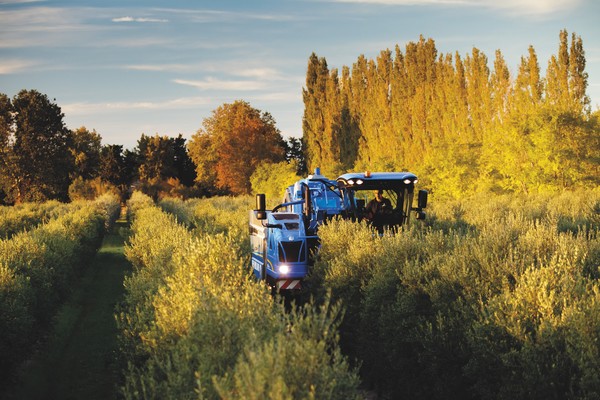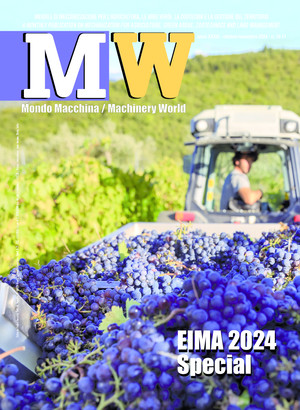
Superintensive olive growing: mechanized harvesting
Olive harvesting systems were developed since after World War II and are now highly efficient. Historical experiences in the field, different types of machines, and new technologies that match the plant structure and efficiently replace labor
the olive sector, the need to reduce labor to limit costs was already being felt in the late 1950s. Thus began a process of modernization aimed at identifying new forms of breeding characterized by plants with contained development such as palmetto, hedge, bush, etc. Italy plays a leading role in this context.
At the same time, the first attempts at the mechanization of harvesting resulted in the rise of trunk shakers. The use of trunk shakers was the starting point for a modernization process aimed at achieving specialized and intensive olive cultivation with high efficiency in terms of yield increases and cost reductions. On the other hand, the concurrent use of machines operating directly on the foliage did not register equal success, despite some good solutions proposed, which are still highly valid today, such as combing heads.
After a stagnation period, this drive for innovation only found new impetus in the early 1990s in Spain, and more specifically in Cataluña, with the planting of the first superintensive plants. These plants are characterized by planting densities capable of exceeding 2,000 plants/ha. The crucial aspect of this model lies in the methodology for harvesting drupes, focused on the machines already adopted for grape harvesting, called grape harvesters or diggers, specifically modified to make them suitable also for olive harvesting. A paradigm shift, this, from the classic machine-plant pair as it was understood until then - where it is up to the machine to adapt to the structure of the olive tree - which is opposed by the concept in which it is the plant that has to adapt to the machine type.
The history of grape harvesters goes back a long way. It began in the years following the end of World War II when the first models of grape-growing facilitating machines started to be manufactured in France. A lot of roads have been covered since then. Some steps can be considered milestones of innovation, and several have been the constructive solutions proposed over the years, more and more valuable and rational, finally leading to the realization of machines as they are currently conceived, in which greater specificity for olive trees is also sought.
Then, from these, those based on horizontal shaking through rods or beaters were implemented to be able to operate even on vineyards with wall forms, which are now as then among the most common farming systems. Today, the use of these machines in the superintensive model is based on this latter concept.
In Italy, for a variety of reasons, including the orography of the territory, small farm size, etc., such innovations took hold more slowly. Nevertheless, the contribution provided by manufacturers has been interesting. For example, the Italian firm Volentieri developed in 1978 a towed rather than the self-propelled type of grape harvester. A further noteworthy solution was proposed by the Pasquali company, in which rotating reels found application in place of the more classical rod shaking elements. This is even more noteworthy considering that it was used for modern large olive harvesting machines such as the Colossus.
More or less in those years, the independent pendulum header and the harvesting hopper were developed, and other construction solutions were adopted. Further developments took place in the following years, so today, these machines have reached very high technological peaks, also thanks to the giant strides made by sensor technology.
The superintensive model is designed for short-term investment. Its convenience is still debated today, but given the centuries-old history of the olive tree, it is still too "new" to be entirely judged. It is emblematic that it adjusts as more and more knowledge is acquired: for example, there has been a shift from the initial monocone training form with a central axis up to 4 m high, with the last meter and a half flexible to avoid damage by the machine to a freer structure by eliminating, where possible, braces and plant support structures for the purpose also of making pruning operations more straightforward and less burdensome. Moreover, studies on varieties, yields and their adaptability to the model, as well as on the best way to manage plants once they reach the end of their economic life, are still in the making.
What is certain is that with the superintensive model, in a market where extra virgin olive oil prices are often far from satisfactory, the achievable advantage in terms of reduced harvesting costs is considerable because it requires, on average, between two and three hours of work per hectare depending on the working conditions.
The main difference these machines feature when operating on olive trees instead of vines is the increased number of shaking elements better to adapt them to the olive grove's productive range. In addition, to remove foreign bodies, sophisticated systems such as those used instead for harvesting are not employed. Still, they are limited to fans arranged on the conveying units. At the same time, the addition of a conveyor at the front of the harvesting tunnel is optional to facilitate the entry of the row into the picking unit.
The heart of the system is the drupe-shaking apparatus driven by a connecting rod-crank type of kinematics or by eccentrics, which vibrates the structures on which the beaters are hinged. The oscillations produced result in vibrations to the plant of constant amplitude and frequency that can vary between 450 and 480 strokes per minute. While the principle remains the same, the shape of the rods varies according to the manufacturer. For example, in some models, there are single-body recurved shakers with both ends hinged, to which additional beaters can be added at one free end. In others, each shaker is independent and is attached to a shaker-holder plate at the front and the rear to a flexible fastening system. In others, the shaker elements are not only aligned but spread over two different height bands. Studies show efficiency in transmitting vibrations from the machine to the plant of about 60 percent, with resulting acceleration values of less than 300 ms-2. More than 90% of the crop on the plant gets successfully harvested.
The machines proceed to straddle the row, continually detaching the drupes from the plants, thus allowing them to be intercepted and transported. Again, there are different solutions proposed: some manufacturers adopt interceptor assemblies, consisting of two sets of plastic flakes that open as the plant passes, separate from the conveying ones, which are positioned outside and consist of rubber mats equipped with transverse vanes. In others, the intercepting and conveying units form a single structure, with two chains of deformable norie offset from each other to ensure tightness.
Damage to the plants is generally limited to the most vigorous and protruding branches in the inter-row due to improperly performed pruning. At the same time, on drupes, there are no critical issues. It is obviously necessary to design the plants with the idea of making the action of the integral harvesting system more efficient, for example, by increasing the length of the rows and limiting problems of a logistical nature such as narrow headlands, insufficient viability, high slopes.
Finally, the possibility of taking advantage of technological packages ranging from automatic guidance, and on-board weighing, to yield mapping, tracking of worked rows, etc., makes them increasingly responsive to the growing need to be able to manage production processes not only based on professional experience but also the parallel support of the information and digital technologies.The latter to optimize field operations, improving labor productivity and guide farmers' decisions according to the spatial and temporal variability of production.








